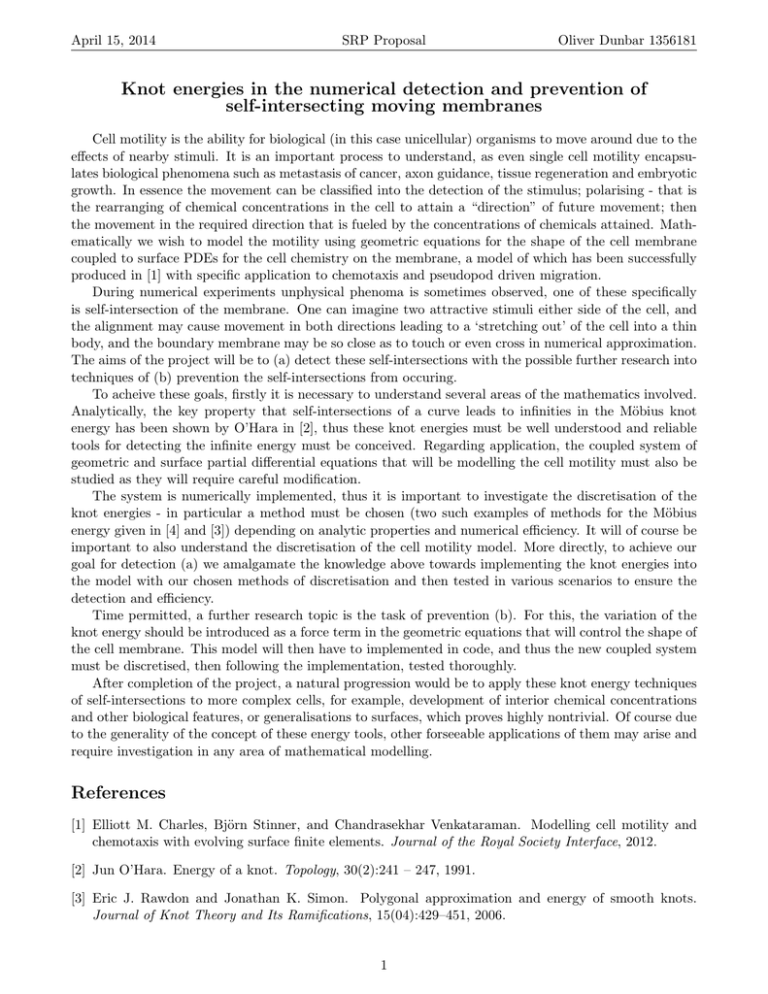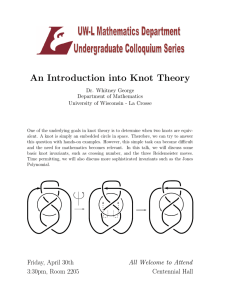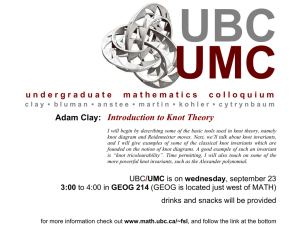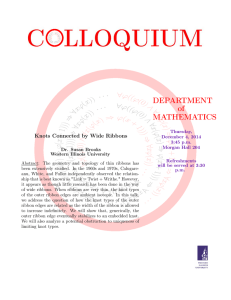Knot energies in the numerical detection and prevention of
advertisement

April 15, 2014 SRP Proposal Oliver Dunbar 1356181 Knot energies in the numerical detection and prevention of self-intersecting moving membranes Cell motility is the ability for biological (in this case unicellular) organisms to move around due to the effects of nearby stimuli. It is an important process to understand, as even single cell motility encapsulates biological phenomena such as metastasis of cancer, axon guidance, tissue regeneration and embryotic growth. In essence the movement can be classified into the detection of the stimulus; polarising - that is the rearranging of chemical concentrations in the cell to attain a “direction” of future movement; then the movement in the required direction that is fueled by the concentrations of chemicals attained. Mathematically we wish to model the motility using geometric equations for the shape of the cell membrane coupled to surface PDEs for the cell chemistry on the membrane, a model of which has been successfully produced in [1] with specific application to chemotaxis and pseudopod driven migration. During numerical experiments unphysical phenoma is sometimes observed, one of these specifically is self-intersection of the membrane. One can imagine two attractive stimuli either side of the cell, and the alignment may cause movement in both directions leading to a ‘stretching out’ of the cell into a thin body, and the boundary membrane may be so close as to touch or even cross in numerical approximation. The aims of the project will be to (a) detect these self-intersections with the possible further research into techniques of (b) prevention the self-intersections from occuring. To acheive these goals, firstly it is necessary to understand several areas of the mathematics involved. Analytically, the key property that self-intersections of a curve leads to infinities in the Möbius knot energy has been shown by O’Hara in [2], thus these knot energies must be well understood and reliable tools for detecting the infinite energy must be conceived. Regarding application, the coupled system of geometric and surface partial differential equations that will be modelling the cell motility must also be studied as they will require careful modification. The system is numerically implemented, thus it is important to investigate the discretisation of the knot energies - in particular a method must be chosen (two such examples of methods for the Möbius energy given in [4] and [3]) depending on analytic properties and numerical efficiency. It will of course be important to also understand the discretisation of the cell motility model. More directly, to achieve our goal for detection (a) we amalgamate the knowledge above towards implementing the knot energies into the model with our chosen methods of discretisation and then tested in various scenarios to ensure the detection and efficiency. Time permitted, a further research topic is the task of prevention (b). For this, the variation of the knot energy should be introduced as a force term in the geometric equations that will control the shape of the cell membrane. This model will then have to implemented in code, and thus the new coupled system must be discretised, then following the implementation, tested thoroughly. After completion of the project, a natural progression would be to apply these knot energy techniques of self-intersections to more complex cells, for example, development of interior chemical concentrations and other biological features, or generalisations to surfaces, which proves highly nontrivial. Of course due to the generality of the concept of these energy tools, other forseeable applications of them may arise and require investigation in any area of mathematical modelling. References [1] Elliott M. Charles, Björn Stinner, and Chandrasekhar Venkataraman. Modelling cell motility and chemotaxis with evolving surface finite elements. Journal of the Royal Society Interface, 2012. [2] Jun O’Hara. Energy of a knot. Topology, 30(2):241 – 247, 1991. [3] Eric J. Rawdon and Jonathan K. Simon. Polygonal approximation and energy of smooth knots. Journal of Knot Theory and Its Ramifications, 15(04):429–451, 2006. 1 April 15, 2014 SRP Proposal [4] Sebastian Scholtes. Discrete Möbius energy. arXiv:1311.3056v1, 2013. 2 Oliver Dunbar 1356181




